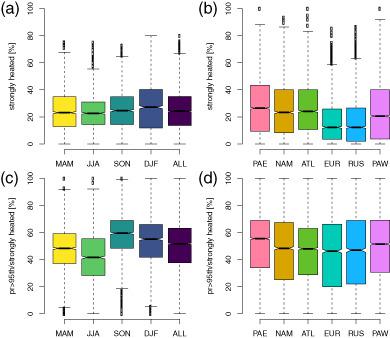当前位置:
X-MOL 学术
›
Atmos. Sci. Lett.
›
论文详情
Our official English website, www.x-mol.net, welcomes your
feedback! (Note: you will need to create a separate account there.)
Quantifying the link between heavy precipitation and Northern Hemisphere blocking—A Lagrangian analysis
Atmospheric Science Letters ( IF 2.0 ) Pub Date : 2020-06-18 , DOI: 10.1002/asl.999 Sina Lenggenhager 1 , Olivia Martius 1, 2
Atmospheric Science Letters ( IF 2.0 ) Pub Date : 2020-06-18 , DOI: 10.1002/asl.999 Sina Lenggenhager 1 , Olivia Martius 1, 2
Affiliation

|
Atmospheric blocks strongly influence surface weather, including extremes such as heat waves and cold spells. Recently, diabatic heating and associated upper‐tropospheric potential vorticity (PV) modification have been identified as important modulators of atmospheric blocking dynamics. Also, robust links between atmospheric blocks and proximate heavy precipitation events have been established. This leads to the question of the extent to which diabatic heating associated with heavy precipitation events influences Northern Hemisphere blocking. This study uses 5 years of 3‐day back trajectories started from objectively identified blocks in the ERA‐Interim dataset to investigate this relationship. A substantial fraction of air parcels in blocks pass through heavy precipitation areas. The exact fraction depends on the choice of heavy precipitation threshold. Roughly 19% of all the trajectories in a block pass a heavy precipitation area (>95th percentile) area while being saturated. Of the air parcels in a block that are heated at least 5 K, 60% pass a heavy precipitation area while saturated. This fraction varies with the season and geographical area. The overall fraction is lowest in summer and highest in winter, higher over oceans than over land, and higher over the Pacific than over the Atlantic. In summer, heating is relevant over the continents and heating over North America influences blocks over the eastern Atlantic. For summer blocks in the North Atlantic and over Scandinavia, heating happens partly over the European continent.
中文翻译:

量化强降水与北半球阻塞之间的联系——拉格朗日分析
大气块强烈影响地表天气,包括热浪和寒流等极端天气。最近,非绝热加热和相关的对流层上层位涡(PV)修正已被确定为大气阻塞动力学的重要调制器。此外,已经建立了大气块和邻近的强降水事件之间的强大联系。这导致了与强降水事件相关的非绝热加热在多大程度上影响北半球阻塞的问题。本研究使用从 ERA-Interim 数据集中客观识别的区块开始的 5 年 3 天回溯轨迹来研究这种关系。块中的很大一部分气团穿过强降水区。确切的分数取决于强降水阈值的选择。块中大约 19% 的所有轨迹在饱和时通过强降水区(> 95%)区域。在块中被加热至少 5 K 的空气块中,60% 在饱和时通过强降水区。该比例随季节和地理区域而变化。总体比例在夏季最低,冬季最高,海洋高于陆地,太平洋高于大西洋。在夏季,供暖与各大洲有关,而北美的供暖会影响东大西洋的区块。对于北大西洋和斯堪的纳维亚半岛的夏季街区,取暖部分发生在欧洲大陆。95%)区域同时饱和。在块中被加热至少 5 K 的空气块中,60% 在饱和时通过强降水区。该比例随季节和地理区域而变化。总体比例在夏季最低,冬季最高,海洋高于陆地,太平洋高于大西洋。在夏季,供暖与各大洲有关,而北美的供暖会影响东大西洋的区块。对于北大西洋和斯堪的纳维亚半岛的夏季街区,取暖部分发生在欧洲大陆。95%)区域同时饱和。在块中被加热至少 5 K 的空气块中,60% 在饱和时通过强降水区。该比例随季节和地理区域而变化。总体比例在夏季最低,冬季最高,海洋高于陆地,太平洋高于大西洋。在夏季,供暖与各大洲有关,而北美的供暖会影响东大西洋的区块。对于北大西洋和斯堪的纳维亚半岛的夏季街区,取暖部分发生在欧洲大陆。总体比例在夏季最低,冬季最高,海洋高于陆地,太平洋高于大西洋。在夏季,供暖与各大洲有关,而北美的供暖会影响东大西洋的区块。对于北大西洋和斯堪的纳维亚半岛的夏季街区,取暖部分发生在欧洲大陆。总体比例在夏季最低,冬季最高,海洋高于陆地,太平洋高于大西洋。在夏季,供暖与各大洲有关,而北美的供暖会影响东大西洋的区块。对于北大西洋和斯堪的纳维亚半岛的夏季街区,取暖部分发生在欧洲大陆。
更新日期:2020-06-18
中文翻译:

量化强降水与北半球阻塞之间的联系——拉格朗日分析
大气块强烈影响地表天气,包括热浪和寒流等极端天气。最近,非绝热加热和相关的对流层上层位涡(PV)修正已被确定为大气阻塞动力学的重要调制器。此外,已经建立了大气块和邻近的强降水事件之间的强大联系。这导致了与强降水事件相关的非绝热加热在多大程度上影响北半球阻塞的问题。本研究使用从 ERA-Interim 数据集中客观识别的区块开始的 5 年 3 天回溯轨迹来研究这种关系。块中的很大一部分气团穿过强降水区。确切的分数取决于强降水阈值的选择。块中大约 19% 的所有轨迹在饱和时通过强降水区(> 95%)区域。在块中被加热至少 5 K 的空气块中,60% 在饱和时通过强降水区。该比例随季节和地理区域而变化。总体比例在夏季最低,冬季最高,海洋高于陆地,太平洋高于大西洋。在夏季,供暖与各大洲有关,而北美的供暖会影响东大西洋的区块。对于北大西洋和斯堪的纳维亚半岛的夏季街区,取暖部分发生在欧洲大陆。95%)区域同时饱和。在块中被加热至少 5 K 的空气块中,60% 在饱和时通过强降水区。该比例随季节和地理区域而变化。总体比例在夏季最低,冬季最高,海洋高于陆地,太平洋高于大西洋。在夏季,供暖与各大洲有关,而北美的供暖会影响东大西洋的区块。对于北大西洋和斯堪的纳维亚半岛的夏季街区,取暖部分发生在欧洲大陆。95%)区域同时饱和。在块中被加热至少 5 K 的空气块中,60% 在饱和时通过强降水区。该比例随季节和地理区域而变化。总体比例在夏季最低,冬季最高,海洋高于陆地,太平洋高于大西洋。在夏季,供暖与各大洲有关,而北美的供暖会影响东大西洋的区块。对于北大西洋和斯堪的纳维亚半岛的夏季街区,取暖部分发生在欧洲大陆。总体比例在夏季最低,冬季最高,海洋高于陆地,太平洋高于大西洋。在夏季,供暖与各大洲有关,而北美的供暖会影响东大西洋的区块。对于北大西洋和斯堪的纳维亚半岛的夏季街区,取暖部分发生在欧洲大陆。总体比例在夏季最低,冬季最高,海洋高于陆地,太平洋高于大西洋。在夏季,供暖与各大洲有关,而北美的供暖会影响东大西洋的区块。对于北大西洋和斯堪的纳维亚半岛的夏季街区,取暖部分发生在欧洲大陆。











































 京公网安备 11010802027423号
京公网安备 11010802027423号